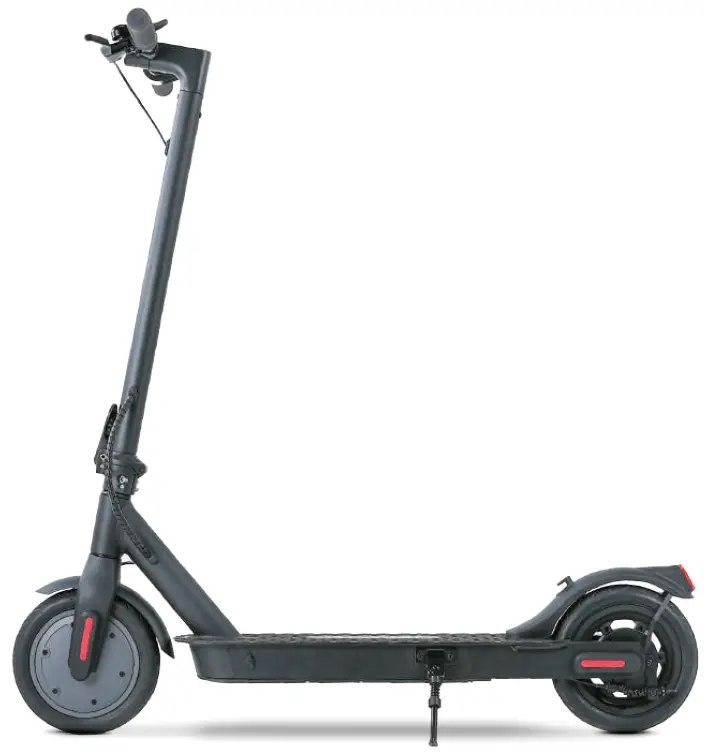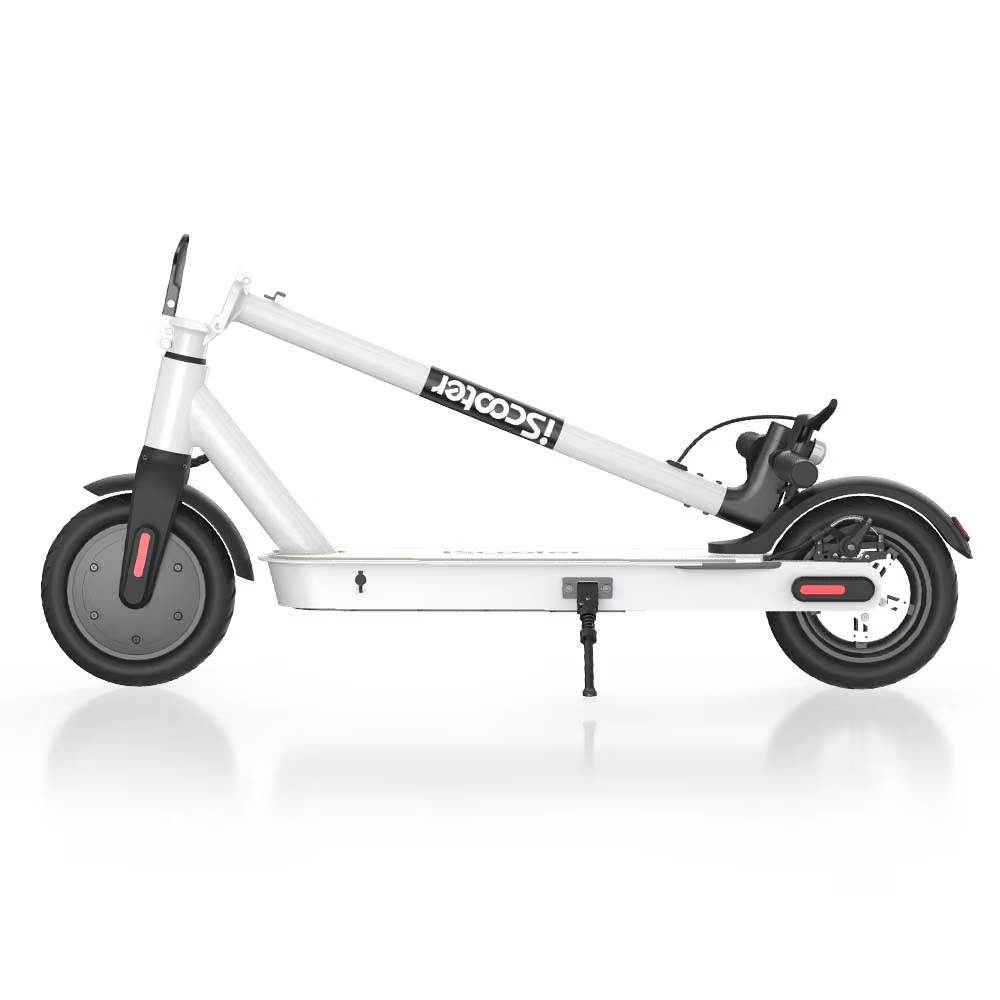Quick Take
The iScooter i8 keeps things simple; however, it still solves real commuting problems. It is light, it folds fast, and it feels predictable on flat city routes. Moreover, beginners appreciate the calm throttle and tidy cockpit. Therefore, students, first-time owners, and mixed-mode commuters will find it easy to live with. For specs and buying info in one place, see iScooter i8 — Specs & Details.
Who This Scooter Is For
If your daily loop is short and mostly flat, the i8 makes sense. In particular, campus paths, neighborhood streets, and last-mile hops are its home turf. Additionally, it suits riders who combine train or bus segments with a quick ride on either end. On the other hand, hill lovers and long-range commuters should look elsewhere. Ultimately, the i8 favors carry weight, simplicity, and budget over brute force.
Key Specs (At a Glance)
- Motor: 350W front hub (single)
- Top Speed: up to ~18 mph in ideal conditions
- Battery: 36V, ~5.2 Ah class
- Range (claimed): up to ~12 miles; real-world ~6–10 for most riders
- Weight: ~26.4 lb (about 12 kg)
- Tires: 8.5″ pneumatic (inner-tube) class
- Water Resistance: IP54 splash resistance
- Fold: Quick latch with compact footprint
- Brakes: Mechanical with electronic assist (class typical)
As always, speed and range depend on rider weight, tire pressure, wind, temperature, and terrain; consequently, plan with a buffer.
Design & Build: Simple, Clean, and Purposeful
The i8 favors clean lines and sensible choices. Consequently, the frame stays light while the deck sits low for easy mounting. The stem feels steady at city speeds; meanwhile, the clamp locks with a direct, reassuring motion. Furthermore, the cockpit avoids clutter, so new riders settle in quickly. The display is legible, buttons are obvious, and the deck rubber grips well even in damp sneakers. Overall, the scooter looks simple without looking cheap.

Setup & First Ride: Friendly from Minute One
Unboxing is straightforward. First, attach the bars and inflate tires to the recommended PSI. Next, charge to full before your maiden ride. Then, take a relaxed stance: front foot forward, rear foot angled, elbows bent. As a result, the i8’s gentle throttle ramp feels composed rather than jumpy. Finally, do a short neighborhood loop to confirm brakes, PSI, and latch tightness before tackling traffic.
Performance & Power Delivery: City Pace, Not Speedway
The 350W hub prioritizes usable thrust over theatrics. Accordingly, takeoffs are smooth, not jerky, which helps balance at low speed. On bike lanes, you’ll cruise near pedal traffic and pass joggers comfortably. Top speed claims hover around 18 mph; nevertheless, most riders settle into a practical 12–16 mph due to surfaces, wind, and comfort. Importantly, that range keeps your head clear for hazards like curbs, driveways, and door zones.
Hill Behavior
Short, mild grades are fine. However, long or steep climbs drain pace quickly, especially for heavier riders. Thus, if your commute includes extended hills, consider a higher-output scooter or plan to crest at a calmer pace. In short, the i8 is happiest on flats.
Handling & Stability: Predictable, Not Nervous
Handling defines trust as much as power does. Consequently, the i8’s neutral steering and sensible bar width matter. Small inputs guide your line; moreover, mid-corner seams do less to unsettle the chassis. Meanwhile, the 8.5″ air tires filter high-frequency buzz, so hands and knees feel fresher after rough blocks. Overall, you ride with light hands rather than a death grip, which reduces fatigue and improves control.
Ride Comfort: Tires Do the Heavy Lifting
There’s no suspension here; instead, the i8 relies on tire volume and smart geometry. Therefore, 8.5″ pneumatic tires soften cracks and expansion joints surprisingly well at city speeds. Nevertheless, pressure matters. Specifically, under-inflation feels mushy and eats range; over-inflation feels skittish and harsh. Accordingly, set PSI within the recommended window and check weekly. Additionally, adopt a slightly forward lean with soft knees; as a result, your body becomes an effective damper.
Braking & Safety: Confidence Begins with Setup
Budget commuters typically blend a mechanical brake with electronic motor assist. Likewise, the i8 benefits from five minutes of post-shakedown tuning. First, center the caliper so the rotor spins rub-free. Then, adjust cable tension until the lever bites predictably. Afterward, run three sets of progressive stops in a safe lot. Consequently, you’ll learn tire grip, lever throw, and stopping distance before you enter traffic. In wet weather, slow earlier, brake in a straight line, and avoid paint or metal plates. Finally, add a brighter bar light and a small rear flasher if you ride at night often—redundancy increases visibility at awkward angles.
Range: Realistic Numbers and Easy Wins
The i8’s claim sits near 12 miles under ideal conditions. In reality, plan for 6–10 miles at moderate pace on mixed terrain. Even so, you can stretch distance with simple habits:
- Ride one mode lower whenever you’re not rushed; therefore, current draw stays modest.
- Keep PSI on point; otherwise, under-inflation crushes efficiency and comfort.
- Ease into the throttle; as a result, you reduce heat and save watts.
- Carry momentum toward reds and stop signs; moreover, timing lights prevents sprint-and-brake waste.
- Top up mid-day if your loop sits near the edge; consequently, range anxiety disappears.
Additionally, treat the battery well for long-term capacity: avoid deep discharges, store indoors, and—on hot days—let the pack rest a few minutes before charging.
Portability & Storage: The i8’s Superpower
Carry weight changes everything. At ~26.4 lb, the i8 is easy to lift, stash, and maneuver. Therefore, mixed-mode commuters can step onto buses, trains, and elevators without drama. Moreover, the quick fold and balanced carry point keep the package from see-sawing into shins. If you carry daily, add a soft handle wrap; consequently, palms stay happier. At home or work, a small mat catches drips and grit after wet rides; thus, floors stay clean.

Controls & Display: Minimal, Clear, and App-Optional
The interface is intentionally simple. Consequently, there’s less fiddling and more riding. You power on, choose a mode, toggle lights, and go. If you like data, reset the trip meter after each ride and note bars remaining; over time, you’ll understand your personal range across seasons and routes. In the end, knowledge beats any brochure estimate.
Weather & Water: Sensible Boundaries
The i8 carries IP54 splash resistance. Accordingly, it tolerates drizzle and damp streets with caution. However, deep puddles and pressure washing are out. After wet rides, dry the charge port and wipe the deck. Otherwise, lingering moisture can corrode connectors. In winter, expect reduced range because cold cells deliver fewer amp-hours; therefore, ride a calmer mode or plan a top-up.
Daily Ownership: What Still Feels Good After Month Three
Some budget scooters rattle themselves loose by week six. By contrast, the i8 stays tight if you follow a tiny routine. Each month, torque key bolts lightly, check pad alignment, and set PSI. Additionally, wipe grit off moving parts and keep the latch clean. Consequently, noise stays low and feel stays high. Meanwhile, your folding technique improves, doors become easier, and tight spaces feel less intimidating. Ultimately, the scooter fades into the background and your commute gets simpler.
Maintenance: A 15-Minute Monthly Ritual
- Torque check: stem clamp, caliper mount, rotor bolts—but don’t over-torque.
- Brake tune: center the caliper, confirm bite point, and verify rub-free spin.
- Tires: inspect tread, remove embedded debris, and set PSI.
- Battery care: avoid full drains, keep the port dry, and store at room temperature.
- Cleaning: wipe dust and road film; furthermore, keep the latch grit-free.
- Cables: scan for pinch points or fray; if needed, adjust routing.
- Test loop: ride a block, do two progressive stops, and listen for new noises.
As a result, small issues never become big repairs.
Accessories That Earn Their Keep
- Helmet: a lightweight city lid with solid vents; safety first.
- Lights: a brighter handlebar beam and a secondary rear flasher; moreover, redundancy boosts visibility.
- Lock: a compact U-lock for café stops; alternatively, a short hardened chain works.
- Phone mount: choose vibration-damping if you use maps.
- Portable pump: even a tiny hand pump beats guessing PSI.
- Gloves: padded palms reduce buzz on rough corridors.
- Fender flap: a small extension reduces back-spray.
Ultimately, carry what you’ll use; otherwise, it just adds weight.
Comparisons: Where the i8 Sits in the Real World
Versus heavier 48V commuters
Bigger scooters sprint harder and hold speed on hills; however, they weigh much more. Therefore, if you carry daily, mass dominates happiness. The i8 trades peak output for real portability and, in many cases, that’s the smarter compromise.
Versus similar 36V budget models
Specs can look identical; nevertheless, geometry and tires separate winners from wallflowers. Accordingly, the i8’s 8.5″ air tires and low carry weight give it an edge for mixed-mode commuting.
Versus solid-tire scooters
Solid tires kill flats; however, they also increase vibration and reduce wet grip. Consequently, riders on rough blocks often prefer air tires. The i8 chooses comfort first.
Versus “budget suspension” options
Cheap suspension adds parts without real damping; therefore, it often disappoints. In contrast, the i8’s tire-first approach feels better on real streets and keeps weight low.
Buying Advice: Map Your Actual Route
Before you buy, measure miles, count lights, and note hills. Then, match the scooter to the route. If your loop is short, efficiency modes and good PSI make life easy. If stairs await, test-carry ~26–28 lb in a backpack; thus, you’ll know the true feel before day one. Finally, budget for a helmet, a brighter light, and a compact lock so you start safe and stay rolling.
Sustainability & Long-Term Ownership
Scooters cut short car trips; therefore, they reduce emissions and congestion. Yet, sustainability also means durability. Fortunately, the i8’s simple design uses fewer parts and a smaller battery than long-range models. Consequently, responsible charging, indoor storage, and basic maintenance extend life while minimizing waste.
Common Mistakes to Avoid
- Letting PSI drift low—therefore, flats, drag, and wobble follow.
- Over-tightening the stem clamp—consequently, creaks and deformation can occur.
- Ignoring rotor rub—as a result, you waste energy and chew pads.
- Charging while damp—therefore, corrosion sets in fast.
- Parking in full sun all day—meanwhile, heat ages cells and plastics.
- Riding too fast for conditions—ultimately, confidence beats bravado.
Pros & Cons
Pros
- Ultra-light ~26.4 lb carry weight
- Quick fold and compact footprint
- 8.5″ pneumatic tires for real comfort
- Predictable throttle and calm handling
- IP54 splash resistance for light rain
- Budget-friendly entry point
Cons
- Short real-world range for longer commutes
- Modest hill power on extended grades
- No suspension; careful line choice still matters
- Basic brake hardware that needs careful setup
FAQs
How fast is the iScooter i8?
Up to around 18 mph in ideal conditions; however, most riders cruise near 12–16 mph on typical streets.
What range should I expect?
Plan for 6–10 miles at moderate pace; in winter, cold air reduces that.
Can I ride it in the rain?
Treat it as IP54 splash-resistant; therefore, light drizzle is fine with caution, but avoid deep puddles and pressure washing.
Does it have suspension?
No; instead, it relies on 8.5″ air tires and correct PSI. Accordingly, keep pressure in range.
Is it good for transit?
Yes; moreover, the ~26.4 lb carry weight and quick fold make transfers easy.
Final Verdict
The iScooter i8 doesn’t try to be everything. Instead, it tries to be easy, portable, and predictable—and it succeeds. Consequently, short trips become simpler and cheaper. If you value light weight and fast folding more than power and range, then the i8 belongs near the top of your shortlist.



